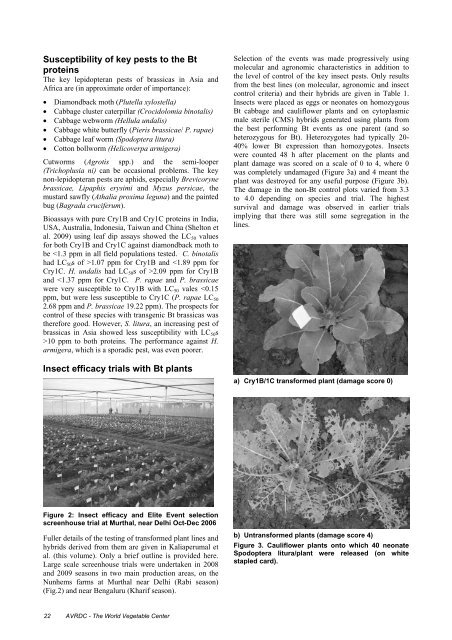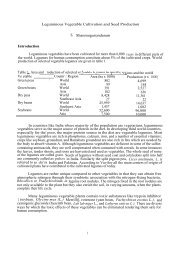- Page 1 and 2: PROCEEDINGSThe Sixth International
- Page 3 and 4: PROCEEDINGSThe Sixth International
- Page 5 and 6: Table of ContentsForewordixAcknowle
- Page 7 and 8: Myco‐Jaal® - A novel formulation
- Page 9 and 10: ForewordVegetable brassicas such as
- Page 11: AcknowledgementsThe Sixth Internati
- Page 15 and 16: Behavioral and geneticcomponents of
- Page 17 and 18: more wandering behavior in the pres
- Page 19 and 20: influenced whether larvae remained
- Page 21 and 22: CLIMEX calculates a growth index (G
- Page 23 and 24: Table 1 (continued)LimitingprocessW
- Page 25 and 26: Figure 5. Observed DBM light trap c
- Page 27 and 28: Rising to the challenge: anational
- Page 29 and 30: Table 1. List of insecticides for w
- Page 31 and 32: Progress and challengesin the Bt br
- Page 33: mixtures. One third of farmers were
- Page 37 and 38: o The Genetics Engineering Approval
- Page 39 and 40: AVRDC; A. Rauf of Bogor University
- Page 41: SESSION 2Biology, ecology and behav
- Page 44 and 45: fields of Thondamuthur village, Coi
- Page 46 and 47: Table 2. Morphometrics of C. binota
- Page 48 and 49: On the basis of LC 50 values, the s
- Page 50 and 51: Natural mortality ofPlutella xylost
- Page 52 and 53: (x10 magnification) and excess eggs
- Page 54 and 55: Figure 2. Lifetables for insect coh
- Page 56 and 57: Diadegma semiclausum is well establ
- Page 58 and 59: Diurnal behavior ofnaturally micros
- Page 60 and 61: changed after the eggs were counted
- Page 62 and 63: Geden, C. J., Long, S. J., Rutz, D.
- Page 64 and 65: Scaptomyza flava (GP Walker, unpubl
- Page 66 and 67: longer distance migrations into the
- Page 68 and 69: FIGURESFigures 1A & B. Mean number
- Page 70 and 71: Monitoring of cabbagelooper, Tricho
- Page 72 and 73: populations of British Columbia col
- Page 75 and 76: Importance ofglucosinolates indeter
- Page 77 and 78: the importance of glucosinolates in
- Page 79 and 80: Olfactory responses ofPlutella xylo
- Page 81 and 82: Figure. 1: Percentage of adult P. x
- Page 83 and 84: Moorthy, 1992) have reported that p
- Page 85 and 86:
P
- Page 87 and 88:
egg masses and more eggs in total o
- Page 89:
SESSION 4Biological and non‐chemi
- Page 92 and 93:
on cabbage cultivation in one seaso
- Page 94 and 95:
four stages at day 7 post treatment
- Page 96 and 97:
Table 5. Biological effects of 17 e
- Page 98 and 99:
Kelly A Cook. K.a., S.T. Ratcliffe.
- Page 100 and 101:
applied only once every three weeks
- Page 102 and 103:
South Africa was assigned to supply
- Page 104 and 105:
Waladde SM, Leutle MF, Villet MH. 2
- Page 106 and 107:
MATERIALS AND METHODSThe study site
- Page 108 and 109:
Several studies have demonstrated t
- Page 110 and 111:
approach would continue until it ev
- Page 112 and 113:
ecorded in Hod 3 (19.1%), followed
- Page 114 and 115:
plutellae. Many adults of C. plutel
- Page 116 and 117:
litura (SL) which normally live in
- Page 118 and 119:
Table 2. Sizes of m-PX and m-SL fro
- Page 120 and 121:
helping us with the in vivo study.
- Page 122 and 123:
Since temperature is one of the mos
- Page 124 and 125:
Figure 4. Effect of different conce
- Page 126 and 127:
Predators in early seasonbrassica c
- Page 128 and 129:
Table 2. Predators encountered duri
- Page 130 and 131:
Table 5. Sticky trap captures for c
- Page 132 and 133:
dwelling predators, although it is
- Page 134 and 135:
Predators per trap109876543Lycosida
- Page 136 and 137:
Mortality was calculated using Abbo
- Page 138 and 139:
DBM fed on the leaf discs treated w
- Page 140 and 141:
Quality aspects of Bacillusthuringi
- Page 142 and 143:
five applications one week apart fo
- Page 144 and 145:
Antifeedant effect ofAcorus calamus
- Page 146 and 147:
Figure 1. Concentration-antifeedant
- Page 148 and 149:
CONCLUSIONA. calamus extracted in f
- Page 150 and 151:
of D. grandiflora on the growth kin
- Page 152 and 153:
etween antifeedant activity and con
- Page 154 and 155:
Table 2. Antifeedant index (AFI) an
- Page 156:
Field evaluation of insectexclusion
- Page 159 and 160:
Three main Lepidoptera pests were o
- Page 161 and 162:
price (SBD)30.0025.0020.0015.0010.0
- Page 163 and 164:
STATISTICAL ANALYSISThe data collec
- Page 165 and 166:
Myco-Jaal: a novelformulation of Be
- Page 167 and 168:
asexual conidium. The conidia adher
- Page 169 and 170:
Table 1. Efficacy of Myco-Jaal on y
- Page 171 and 172:
Susceptibility ofdiamondback moth a
- Page 173 and 174:
Table 1. Toxicity of Cry1Ac to fiel
- Page 175 and 176:
ReferencesAbbott WS. 1925. A method
- Page 177 and 178:
76°58′17″E), Tamil Nadu, India
- Page 179 and 180:
International Workshop, Talekar NS,
- Page 181 and 182:
Table 3. Effect of Neem limonoids o
- Page 183 and 184:
Figure 1. Structure of neem limonoi
- Page 185 and 186:
catch up with the farming community
- Page 187 and 188:
All treatments were imposed by usin
- Page 189 and 190:
The above results indicate that the
- Page 191 and 192:
A strong negative relationship obse
- Page 193 and 194:
ReferencesAnonymous 2000. Package o
- Page 195 and 196:
egularly causes epizootics in popul
- Page 197 and 198:
treatments. It is evident that DBM
- Page 199 and 200:
Table 1. Effects of three aqueous s
- Page 201 and 202:
egion (Adams, 1959); it is a native
- Page 203 and 204:
Effects of Cry toxins and Bt formul
- Page 205 and 206:
Hilbeck A, Baumgartner M, Fried MP,
- Page 207 and 208:
Table 3. Effect of Cry 1Ba2 on Cote
- Page 209:
SESSION 5Insecticides and insectici
- Page 212 and 213:
time. Within four years of the firs
- Page 214 and 215:
Update on DBM diamideresistance fro
- Page 216 and 217:
In year 2011, Sai Noi and Tha Muang
- Page 218 and 219:
Lahm GP, Cordova D, Barry JD. 2009.
- Page 220 and 221:
Fipronil acts by blocking chloride
- Page 222 and 223:
Table 2. Slope, LC 50 (ppm) and let
- Page 224 and 225:
Figure 2. Lethal dose ratios for fi
- Page 226 and 227:
y the inherent lower susceptibility
- Page 228 and 229:
Diamondback mothresistance to commo
- Page 230 and 231:
of the relative potency of each ins
- Page 232 and 233:
Table 3: Susceptibility of six fiel
- Page 234 and 235:
Spinetoram, a newspinosyn insectici
- Page 236 and 237:
Spinetoram is also highly effective
- Page 238 and 239:
Norte del Estado areas of Guanajuat
- Page 240 and 241:
Insecticide resistancemanagement: s
- Page 242 and 243:
still exist. The second source of i
- Page 244 and 245:
they organized the so called “Dia
- Page 246 and 247:
Recent developments inmanagement of
- Page 248 and 249:
is the reciprocal of the relative p
- Page 250 and 251:
developing thresholds for new brass
- Page 252 and 253:
Table 3: Spinosad (Success®) and i
- Page 254 and 255:
Insecticide sprays are generally ap
- Page 256 and 257:
may still benefit from doing so, ir
- Page 258 and 259:
generations” to Group 28 insectic
- Page 260 and 261:
Management of insecticideresistance
- Page 262 and 263:
Stop cultivation of crucifer crops
- Page 264 and 265:
252 AVRDC - The World Vegetable Cen
- Page 267 and 268:
Impact of reduced-riskinsecticides
- Page 269 and 270:
mines) on the 10 plants in each plo
- Page 271 and 272:
Table 4. Follow up with growers aft
- Page 273 and 274:
Guided by such objective, the Thai
- Page 275 and 276:
establishment rapidly achieved by D
- Page 277 and 278:
Malaysian Agricultural Research and
- Page 279 and 280:
the farmers. We report the developm
- Page 281 and 282:
Table 3. Number of DBM larvae in th
- Page 283 and 284:
Pest status and damage potentialThe
- Page 285 and 286:
Life tableLife table of DBM reveals
- Page 287 and 288:
Bacillus thuringiensis (Bt)Currentl
- Page 289 and 290:
CHEMICAL INSECTICIDESPeter et al. (
- Page 291 and 292:
Manjunath TM. 1972. Biological stud
- Page 293 and 294:
Armyworm, Spodoptera litura Armywo
- Page 295 and 296:
Adoption and perceptionTable 5 show
- Page 297 and 298:
Control of brassica pests -an examp
- Page 299 and 300:
Table 2. A Comparison of IPM and Pe
- Page 301 and 302:
Occurrence and control ofPlutella x
- Page 303 and 304:
Apopul at i on dynami c ( l ar va/
- Page 305 and 306:
Diadegma semiclausumD. semiclausum,
- Page 307 and 308:
Diamondback moth(Plutella xylostell
- Page 309:
SESSION 7Genomic and other novel ap
- Page 312 and 313:
management (IPM) systems (Shelton e
- Page 314 and 315:
Kalra VK, Sharma SS, Chauhan R, Bha
- Page 316 and 317:
Table 2. Segregation analysis based
- Page 318 and 319:
current paper provides detail on th
- Page 320 and 321:
Proteins do not act antagonisticall
- Page 322 and 323:
CONCLUSIONThe transformation events
- Page 324 and 325:
Enhancement of the sterileinsect te
- Page 326 and 327:
optimisation of transformation prot
- Page 328 and 329:
Workshop PresidentsDr. Jacqueline d
- Page 330 and 331:
Participant e‐mail Organization C
- Page 332 and 333:
Author IndexAbuzid, I..............
















